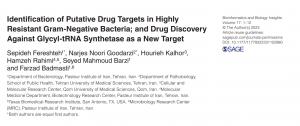
13/09/1402
Identification of Putative Drug Targets in Highly Resistant Gram-Negative Bacteria; and Drug Discovery Against Glycyl-tRNA Synthetase as a New Target
AbstractBackground:Gram-negative bacterial infections are on the rise due to the high prevalence of multidrug-resistant bacteria, and efforts must be made to identify novel drug targets and then new antibiotics. Methods:In the upstream part, we retrieved the genome sequences of 4 highly resistant Gram-negative bacteria (e.g., Acinetobacter baumannii, Klebsiella pneumoniae, Pseudomonas aeruginosa, and Enterobacter cloacae). The core proteins were assessed to find common, cytoplasmic, and essential proteins with no similarity to the human proteome. Novel drug targets were identified using DrugBank, and their sequence conservancy was evaluated. Protein Data Bank files and STRING interaction networks were assessed. Finally, the aminoacylation cavity of glycyl-tRNA synthetase (GlyQ) was virtually screened to identify novel inhibitors using AutoDock Vina and the StreptomeDB library. Ligands with high binding affinity were clustered, and then the pharmacokinetics properties of therapeutic agents were investigated. Results:A total of 6 common proteins (e.g., RP-L28, RP-L30, RP-S20, RP-S21, Rnt, and GlyQ) were selected as novel and widespread drug targets against highly resistant Gram-negative superbugs based on different criteria. In the downstream analysis, virtual screening revealed that Rimocidin, Flavofungin, Chaxamycin, 11,11′-O-dimethyl-14′-deethyl-14′-methylelaiophylin, and Platensimycin were promising hit compounds against GlyQ protein. Finally, 11,11′-O-dimethyl-14′-deethyl-14′-methylelaiophylin was identified as the best potential inhibitor of GlyQ protein. This compound showed high absorption capacity in the human intestine. Conclusion:The results of this study provide 6 common putative new drug targets against 4 highly resistant and Gram-negative bacteria. Moreover, we presented 5 different hit compounds against GlyQ protein as a novel therapeutic target. However, further in vitro and in vivo studies are needed to explore the bactericidal effects of proposed hit compounds against these superbugs.
|